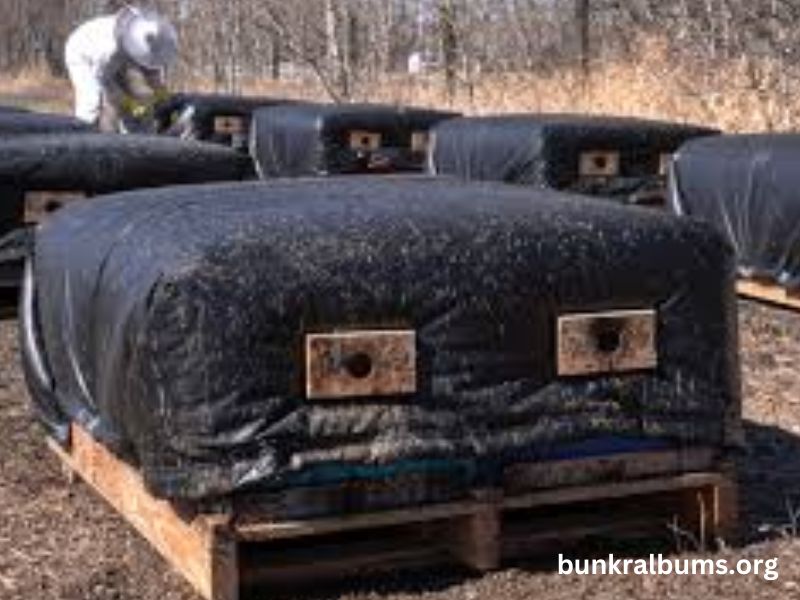As winter approaches, beekeepers face the challenge of protecting their hives from the harsh, cold weather. One of the most effective ways to safeguard a bee colony during the colder months is by using winter bee hive wraps. If you’re searching for “winter bee hive wraps for sale,” you’re likely aware of the importance of insulating your hive. This comprehensive guide will explain what winter bee hive wraps are, why they’re essential, and how they benefit your bees. Additionally, we’ll discuss the various types available on the market and help you choose the right wrap for your apiary.
What Are Winter Bee Hive Wraps?
Winter bee hive wraps are specialized coverings designed to insulate beehives during the winter months. These wraps protect the hive from freezing temperatures, wind, and snow, ensuring that your bees can survive the winter. While honeybees are naturally resilient and can generate warmth within the hive by clustering together, the additional protection provided by a winter wrap helps them conserve energy and reduces the chances of colony collapse.
Winter wraps are typically made from insulating materials such as tar paper, foam, or other weather-resistant materials. These wraps are designed to fit snugly around the hive, providing a layer of insulation while allowing for proper ventilation, which is crucial to prevent moisture buildup.
Importance of Using Winter Bee Hive Wraps
Bees are cold-blooded creatures, meaning they cannot regulate their body temperature as humans do. When winter temperatures drop, bees rely on the heat generated by their collective clustering to survive. However, without sufficient protection, the cold can seep into the hive, causing stress on the bees and increasing their chances of death. Here are some key reasons why winter bee hive wraps are essential for beekeepers:
- Temperature Control: A well-insulated hive allows the bees to maintain an optimal temperature, which is crucial for their survival during winter.
- Energy Conservation: Insulating the hive reduces the amount of energy bees need to expend to generate heat, allowing them to conserve their stored honey.
- Protection from Wind and Snow: Winter bee hive wraps shield the hive from the wind and snow, helping to prevent drafts from entering the hive and freezing the bees.
- Moisture Management: Properly designed wraps allow for ventilation, preventing moisture buildup, which can lead to mold and harm the bees.
- Colony Longevity: Providing insulation helps ensure the survival of the colony, reducing the risk of losing bees and requiring less intervention in the spring.
How to Choose the Right Winter Bee Hive Wrap
When you’re searching for “winter bee hive wraps for sale,” you’ll notice a variety of options available. The right wrap for your hives will depend on factors such as your climate, the size of your hives, and your budget. Below are some of the most popular types of winter bee hive wraps and what you should consider when choosing one.
1. Tar Paper Hive Wraps
Tar paper wraps are one of the most commonly used materials for insulating beehives. Tar paper is inexpensive and provides excellent protection against wind and cold temperatures. It’s a simple, effective way to add an additional layer of warmth to your hive. Beekeepers often secure the tar paper around the hive using staples or a staple gun.
- Pros: Cost-effective, easy to apply, provides wind protection.
- Cons: Does not offer as much insulation as other materials, can get wet if not applied correctly.
2. Foam Insulation Wraps
Foam wraps are made from polystyrene or similar materials, offering a higher level of insulation than tar paper. These wraps are more expensive but provide superior temperature control, helping bees maintain their heat more efficiently. Foam insulation wraps can be found in both rigid and flexible forms.
- Pros: Excellent insulation, durable, and long-lasting.
- Cons: More expensive than tar paper, may require more precise installation.
3. Bee Cozy Winter Wraps
Bee Cozy wraps are specifically designed for beekeeping and are highly regarded for their effectiveness in colder climates. These wraps are made from a thick, insulated material that surrounds the hive and provides maximum protection against cold temperatures. Bee Cozy wraps also allow for proper ventilation, ensuring that moisture doesn’t build up inside the hive.
- Pros: High insulation, easy to use, great for extreme cold.
- Cons: Higher price point, may not be necessary in milder climates.
4. DIY Hive Wraps
For the budget-conscious beekeeper, DIY hive wraps can be an effective solution. Materials such as bubble wrap, old blankets, or even cardboard can be used to insulate a hive. However, it’s important to remember that DIY solutions may not provide the same level of protection as commercially available wraps and could result in moisture buildup if not applied correctly.
- Pros: Cost-effective, customizable.
- Cons: Can be less effective than commercial wraps, risk of improper installation.
How to Install Winter Bee Hive Wraps
Once you’ve chosen the right wrap for your hive, proper installation is key to ensuring that it works effectively. Here’s a step-by-step guide on how to install winter bee hive wraps:
Step 1: Prepare the Hive
Before installing the wrap, ensure that your hive is in good condition. Check for any cracks or gaps in the hive that could allow cold air to enter, and seal them with bee-safe caulking. Additionally, make sure that your hive has adequate ventilation to prevent moisture buildup.
Step 2: Position the Wrap
Carefully position the wrap around the hive, ensuring that it covers all sides. If you’re using a wrap that requires staples or tape, be sure to secure it tightly so that it doesn’t shift or blow away in the wind.
Step 3: Leave Ventilation Space
Proper ventilation is crucial when wrapping a hive for winter. Make sure that the top and bottom entrances of the hive remain unobstructed to allow airflow. This will help prevent moisture buildup inside the hive, which can be deadly to bees.
Step 4: Check the Hive Regularly
Throughout the winter, it’s important to check your hive periodically to ensure that the wrap is still secure and that the hive is properly ventilated. If you notice any signs of moisture buildup or damage to the wrap, make the necessary adjustments to protect your bees.
Benefits of Using Winter Bee Hive Wraps
Using winter bee hive wraps offers numerous benefits to both your bees and your beekeeping operation. By providing insulation, you can help ensure that your colony survives the winter and emerges strong and healthy in the spring. Here are some of the key benefits of using hive wraps:
- Improved Colony Survival: Bees that are properly insulated have a higher chance of surviving the winter, which means you’ll have a strong, productive colony come spring.
- Reduced Honey Consumption: When bees don’t need to expend as much energy to stay warm, they consume less honey. This means more honey can be harvested in the spring.
- Protection from Winter Elements: Hive wraps protect your bees from the elements, including cold temperatures, wind, and snow, helping to reduce the risk of colony loss.
- Peace of Mind for Beekeepers: Knowing that your hive is protected with a wrap allows you to rest easier during the winter months, confident that you’ve taken the necessary steps to ensure your bees’ survival.
Where to Find Winter Bee Hive Wraps for Sale
When looking for “winter bee hive wraps for sale,” there are numerous online and local retailers that offer high-quality products. Beekeeping supply stores often carry a variety of hive wraps, ranging from basic tar paper wraps to advanced insulation systems like Bee Cozy. Additionally, online marketplaces such as Amazon, beekeeping forums, and specialty websites provide a wide selection of options for beekeepers of all experience levels.
Before purchasing, be sure to consider the climate in your area, the size of your hives, and your budget. Reading reviews from other beekeepers can also help you make an informed decision.
Conclusion
Winter bee hive wraps are an essential tool for beekeepers looking to protect their colonies during the cold months. By insulating the hive, you can help your bees conserve energy, reduce honey consumption, and improve their chances of surviving the winter. Whether you choose tar paper, foam, or a specialized wrap like Bee Cozy, the key is to ensure proper installation and ventilation to keep your hive safe.
With winter fast approaching, now is the perfect time to search for “winter bee hive wraps for sale” and invest in the protection your bees need. By taking the necessary steps to insulate your hives, you’ll be rewarded with a healthy, thriving colony come spring.







